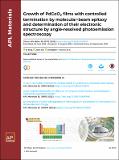Growth of PdCoO2 films with controlled termination by molecular-beam epitaxy and determination of their electronic structure by angle-resolved photoemission spectroscopy
Abstract
Utilizing the powerful combination of molecular-beam epitaxy (MBE) and angle-resolved photoemission spectroscopy (ARPES), we produce and study the effect of different terminating layers on the electronic structure of the metallic delafossite PdCoO2. Attempts to introduce unpaired electrons and synthesize new antiferromagnetic metals akin to the isostructural compound PdCrO2 have been made by replacing cobalt with iron in PdCoO2 films grown by MBE. Using ARPES, we observe similar bulk bands in these PdCoO2 films with Pd-, CoO2-, and FeO2-termination. Nevertheless, Pd- and CoO2-terminated films show a reduced intensity of surface states. Additionally, we are able to epitaxially stabilize PdFexCo1−xO2 films that show an anomaly in the derivative of the electrical resistance with respect to temperature at 20 K, but do not display pronounced magnetic order.
Citation
Song , Q , Sun , J , Parzyck , C , Miao , L , Xu , Q , Hensling , F , Barone , M , Hu , C , Kim , J , Faeth , B , Paik , H , King , P , Shen , K & Schlom , D 2022 , ' Growth of PdCoO 2 films with controlled termination by molecular-beam epitaxy and determination of their electronic structure by angle-resolved photoemission spectroscopy ' , APL Materials , vol. 10 , no. 9 , 091113 . https://doi.org/10.1063/5.0101837
Publication
APL Materials
Status
Peer reviewed
ISSN
2166-532XType
Journal article
Description
Funding: This paper is primarily supported by the U.S. Department of Energy, office of Basic Sciences, Division of Materials Science and Engineering under Award No. DE-SC0002334. C.P acknowledges support from Air Force Office of Scientific Research grant number FA9550-21-1-0168 and National Science Foundation DMR-2104427. P.K. gratefully acknowledges support from the European Research Council (through the QUESTDO project, 714193). Q.X. acknowledges support from the REU Site: Summer Research Program at PARADIM (Grant No. DMR-2150446).Collections
Items in the St Andrews Research Repository are protected by copyright, with all rights reserved, unless otherwise indicated.

